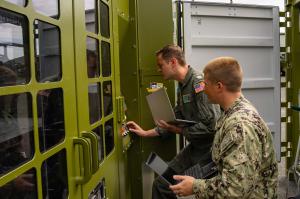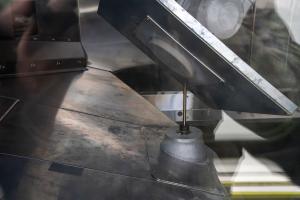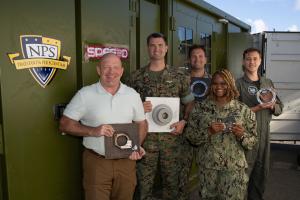
Impact at RIMPAC: NPS Students Enhance Fleet Readiness with 3D Printing Technology

At left, U.S. Marine Corps Cpl. Jacob Bair, assigned to the Marine Innovation Unit, explains the metal properties of a part to Maj. Matt Audette and Lt. Col. Michael Radigan at Marine Corps Base Hawaii during Exercise Trident Warrior 2024.

U.S. Navy Lt. Andrew Staley and Lt. Daniel Lukac, students at the Naval Postgraduate School (NPS), prepare the printing of a ship part using an XSPEE3D expeditionary cold spray printer at Marine Corps Base Hawaii during Exercise Trident Warrior 2024.

A metal bushing for the San Antonio-class amphibious transport dock ship USS Somerset (LPD 25) prints on an XSPEE3D expeditionary cold spray printer at Marine Corps Base Hawaii during Exercise Trident Warrior 2024.
MONTEREY, CALIFORNIA, UNITED STATES, August 16, 2024 /EINPresswire.com/ -- Students and faculty from the Naval Postgraduate School (NPS) conducted expeditionary advanced manufacturing research during the Rim of the Pacific (RIMPAC) and Trident Warrior 2024 exercises demonstrating new technology applications at sea and ashore.
Ten NPS students from the U.S. Navy, U.S. Marine Corps, and U.S. Army, along with representatives from the school’s Consortium for Advanced Manufacturing and Research (CAMRE) and FLEETWERX, spent time at installations and aboard ships during the exercises to experiment with cutting-edge additive manufacturing equipment producing repair parts for a variety of use cases with real-world impact.
The CAMRE team aboard the San Antonio-class amphibious transport dock ship USS Somerset (LPD 25) included NPS students, Marines from the 3rd Marine Expeditionary Force and Marine Innovation Unit, and Soldiers from the 25th Infantry Division. Ashore at Marine Corps Base (MCB) Hawaii, a Joint Advanced Manufacturing Cell (JAMC), led by retired Marine Corps Col. Patrick Tucker, was assembled to focus on readiness challenges where advanced manufacturing could provide a solution.
Applying learned techniques during real scenarios in training environments like RIMPAC, which concluded early this month, allows students and operators in the fleet to better understand the importance and practical impact of their applied research in solving readiness problems.
“At NPS, our primary focus is graduate education,” said Emre Gunduz, Ph.D., an associate professor in NPS’ mechanical and aerospace engineering department and the technical director at CAMRE, who was the principal investigator, along with CAMRE program manager Chris Curran. “For Trident Warrior, the students applied their NPS education in a real operational environment, while at the same time advancing the capabilities of the Navy. This allowed NPS students to see the relevance of their studies and research to real-world Navy challenges, which could greatly enhance learning outcomes here. At the same time, we are targeting the current gaps in the rapid deployment of these emerging technologies.”
NPS Cooperative Research and Development Agreements with industry partners enabled cutting-edge equipment to be explored and included an expeditionary cold spray printer from XSPEE3D, which was co-located with the JAMC on MCB Hawaii, and a hybrid wire directed energy deposition machine from Snowbird Technologies. The Snowbird machine was installed in a 10-foot container and embarked on Somerset for an additive and subtractive capability afloat, joining a pair of Advanced Manufacturing Operational System polymer printers designed by Spencer Koroly, an engineer from Naval Information Warfare Center Pacific.
“Ship and submarine repair is one of our crucial focus areas,” said Navy Lt. Cmdr. Zachary Vrtis, an engineering duty officer currently pursuing a doctorate in mechanical engineering with a dissertation focused on metal additive manufacturing. “We are working to implement advanced metal manufacturing to better supplement traditional fabrication methods, repair fleet assets quicker, and assist in revitalizing the submarine industrial base to meet production goals.”
Advanced manufacturing machines and tools available to NPS use computer-controlled processes to create objects layer by layer from digital designs. This method allows for precise and complex shapes, reduced waste, shortened production times, and customized production from materials like aluminum and steel. These new techniques are tested and refined at the NPS Advanced Manufacturing Center, a new interdisciplinary facility for 3D metal printing and related technologies to explore defense applications.
“It was important to make the leap from ‘thinking differently’ to ‘executing differently’ and show how the Department of Defense (DOD) can pair excess capacity of existing machines with top-tier service members to deliver real metal parts in days, not months,” said Marine Corps Lt. Col. Michael Radigan of the Marine Innovation Unit, who also serves as the government lead on the CAMRE team. “I am truly impressed with what got accomplished and how it was accomplished.”
One significant accomplishment by the NPS team aboard Somerset was using the embarked additive manufacturing technology to repair a reverse osmosis pump, which kept Somerset from terminating its participation in the exercise early.
“It was great to see how resourceful the entire team was on the Somerset in a time of need,” said Marine Corps Maj. Daniel Szurick, a master’s student at NPS. “That’s exactly the naval culture that will allow us to succeed in conflict.”
From an operational perspective, having the right machines and talent on Somerset ensured shipboard equipment could be repaired without impacting operational mission requirements, ultimately reducing the reliance on distant logistics and increasing resiliency. From an experimentation perspective, this research validated the concept of how to employ advanced manufacturing in a contested logistics environment.
“Exercises give us a chance to sharpen our skills, learn from one another, and get real-world experience,” said Vice Adm. John Wade, commander, U.S. Third Fleet. “A lot of hard work went into making sure the equipment worked and that we were trained and certified … to conduct these operations. There is no doubt that we achieved the main objectives of the exercise.”
Navy asset readiness is at risk when the industrial base is limited by agility and depth. Shipboard systems often rely on original equipment manufacturer components, which can have unacceptably long acquisition lead times for legacy systems.
The DOD’s Additive Manufacturing Strategy, released in 2021, is focused on operationalizing 3D printing capabilities. Advanced manufacturing, which includes additive manufacturing, is poised to be a crucial component of solutions offering unprecedented supply chain agility, ensuring the Navy can provide continuous security and stability – anywhere at any time.
“This innovative technology is becoming an increasingly game-changing capability that is improving operational readiness and afloat self-sufficiency,” said Navy Capt. Jeremy Gray, who serves as surface warfare chair at NPS. "The partnership between Commander Naval Surface Forces and NPS is accelerating fleet experimentation and Sailor experience with advanced manufacturing techniques and processes.”
In his capacity as surface warfare chair, Gray works with the fleet and NPS to include research for advanced manufacturing capabilities to get technologies and talent aboard ships for testing. These efforts, combined with those of the NPS CAMRE team and partners, contribute to the operationalization of advanced manufacturing at sea.
“CAMRE offers hands-on education to NPS students and fosters talent and technologies through applied research with operational forces,” said CAMRE Director Garth V. Hobson, Ph.D. “We are dedicated to advancing additive manufacturing education for defense applications and seamlessly integrating these technologies across the Navy, Marine Corps, and joint forces.”
In addition to the NPS CAMRE team, this applied research was supported by U.S. 3rd Fleet, Program Executive Office for Strategic Submarines, the Marine Innovation Unit, and NPS’ Naval Innovation Exchange Additive Manufacturing program.
NPS, located in Monterey, California, provides defense-focused graduate education, including classified studies and interdisciplinary research, to advance the operational effectiveness, technological leadership, and warfighting advantage of the Naval service. Established in 1909, NPS offers master’s and doctorate programs to Department of Defense military and civilians, along with international partners, to deliver transformative solutions and innovative leaders through advanced education and research.
Lt. Cmdr. Ed Early
Naval Postgraduate School
+1 831-656-3567
pao@nps.edu
EIN Presswire does not exercise editorial control over third-party content provided, uploaded, published, or distributed by users of EIN Presswire. We are a distributor, not a publisher, of 3rd party content. Such content may contain the views, opinions, statements, offers, and other material of the respective users, suppliers, participants, or authors.



